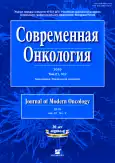Effective use of the endoscopic vacuum system in the comprehensive treatment of a patient with a defect in the abdominal segment of the esophagus after gastrectomy
- Authors: Abu-Khaidar O.B1, Vodoleev A.S2, Pirogov S.S2, Khomiakov V.M2, Riabov A.B2
-
Affiliations:
- N.N. Blokhin National Medical Research Center of Oncology
- P.A. Herzen Moscow Research Institute of Oncology - branch of National Medical Research Center for Radiology
- Issue: Vol 21, No 2 (2019)
- Pages: 51-54
- Section: Articles
- URL: https://journals.rcsi.science/1815-1434/article/view/33525
- DOI: https://doi.org/10.26442/18151434.2019.2.190411
- ID: 33525
Cite item
Full Text
Abstract
Full Text
##article.viewOnOriginalSite##About the authors
Omar B Abu-Khaidar
N.N. Blokhin National Medical Research Center of Oncology
Email: abouhaidar@yandex.ru
Cand. Sci. (Med.) Moscow, Russia
Aleksandr S Vodoleev
P.A. Herzen Moscow Research Institute of Oncology - branch of National Medical Research Center for RadiologyCand. Sci. (Med.) Moscow, Russia
Sergei S Pirogov
P.A. Herzen Moscow Research Institute of Oncology - branch of National Medical Research Center for RadiologyD. Sci. (Med.) Moscow, Russia
Vladimir M Khomiakov
P.A. Herzen Moscow Research Institute of Oncology - branch of National Medical Research Center for RadiologyCand. Sci. (Med.) Moscow, Russia
Andrei B Riabov
P.A. Herzen Moscow Research Institute of Oncology - branch of National Medical Research Center for RadiologyD. Sci. (Med.) Moscow, Russia
References
- Хомяков В.М., Колобаев И.В. Выбор лечебной тактики при несостоятельности пищеводных анастомозов в онкохирургии. Сиб. онкологический журн. 2012 (Прил. 1).
- Weidenhagen R, Gruetzner K.U, Wiecken T et al. Endoscopic vacuum-assisted closure of anastomotic leakage following anterior resection of the rectum: a new method. Surg Endosc 2008; 22: 1818-25.
- Loske G, Müller C. Endoscopic vacuum-assisted closure of upper intestinal anastomotic leaks. Gastrointest Endosc 2009; 69: 601-2.
- Ahrens M, Schulte T, Egberts J et al. Drainage of esophageal leakage using endoscopic vacuum therapy: A prospective pilot study. Endoscopy 2010; 42: 693-8.
- Weidenhagen R, Hartl W.H, Gruetzner K.U et al. Anastomotic leakage after esophageal resection: New treatment options by endoluminal vacuum therapy. Ann Thora Surg 2010; 90: 1674-81.
- Wedemeyer J, Brangewitz M, Kubicka S et al. Management of major postsurgical gastroesophageal intrathoracic leaks with an endoscopic vacuum-assisted closure system. Gastrointest Endosc 2010; 71: 382-6.
- Brangewitz M, Voigtlander T, Helfritz F.A et al. Endoscopic closure of esophageal intrathoracic leaks: Stent versus endoscopic vacuum-assisted closure, a retrospective analysis. Endoscopy 2013; 45: 433-8.
- Schorsch T, Müller C, Loske G. Endoscopic vacuum therapy of perforations and anastomotic insufficiency of the esophagus. Der Chirurg Zeitschrift fur alle Gebiete der operativen Medizen 2014; 85: 1081-93.
- Bludau M, Holscher A.H, Herbold T et al. Management of upper intestinal leaks using an endoscopic vacuum-assisted closure system (e-vac). Surg Endosc 2014; 28: 896-901.
- Moschler O, Nies C, Mueller M.K. Endoscopic vacuum therapy for esophageal perforations and leakages. Endosc Int Open 2015; 3: E554-E558.
- Laukoetter M.G, Mennigen R, Neumann P.A et al. Successful closure of defects in the upper gastrointestinal tract by endoscopic vacuum therapy (evt): A prospective cohort study. Surg Endosc 2017; 31: 2687-96.
- Kuehn F, Schiffmann L, Janisch F et al. Surgical endoscopic vacuum therapy for defects of the upper gastrointestinal tract. J Gastrointest Surg 2016; 20: 237-43.
Supplementary files







